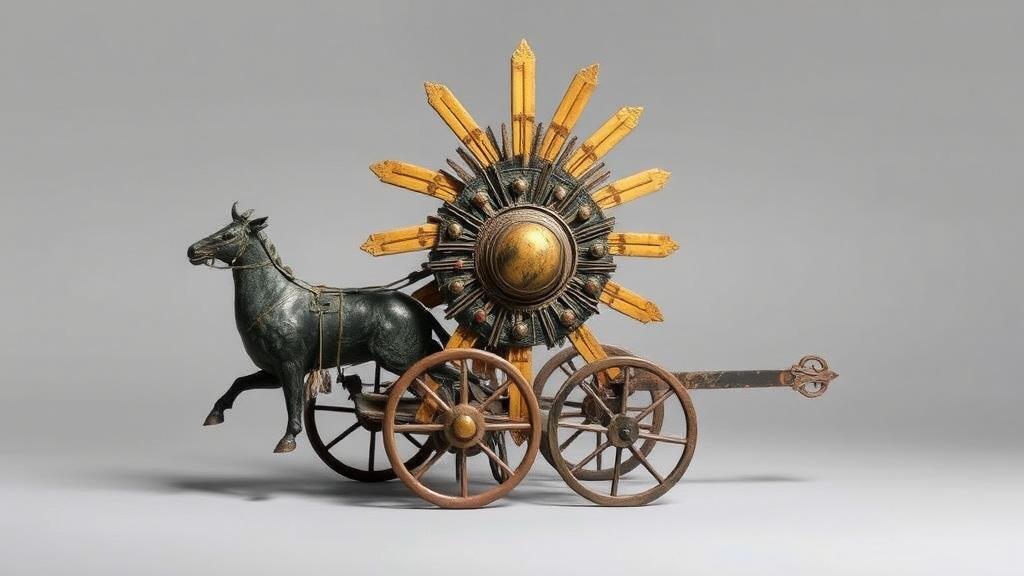Investigating the “Trundholm Sun Chariot,” an artifact depicting solar worship in the Bronze Age.
Investigating the Trundholm Sun Chariot: An Artifact of Solar Worship in the Bronze Age
The Trundholm Sun Chariot is a remarkable artifact that dates back to the Nordic Bronze Age, approximately 1400-1000 BCE. Discovered in 1902 in Trundholm Mose, near the village of Trundholm in Zealand, Denmark, this chariot exemplifies the artistic and spiritual values of ancient societies, reflecting their reverence for solar deities. The chariot not only serves as a rare example of Bronze Age artistry but also provides insights into the religious beliefs and cultural practices during this era.
The Discovery and Description of the Artifact
The Trundholm Sun Chariot was unearthed by a local farmer and subsequently excavated by archaeologists. This remarkable find consists of a bronze sun disc, measuring approximately 23.5 inches in diameter, set atop a wooden chariot model supported by two horses. The craftsmanship of the artifact is exceptional, with intricate details that showcase the advanced metallurgical skills of the time.
Key features of the Trundholm Sun Chariot include:
- A circular bronze disc, believed to represent the sun, decorated with concentric circles and a beaded rim.
- A wooden chariot, with traces of iron, demonstrating the use of multiple materials in its construction.
- A pair of horses crafted from wood that reflect the symbolic journey of the sun across the sky.
Symbolism and Cultural Significance
The Trundholm Sun Chariot is thought to symbolize the daily journey of the sun, a central theme in many ancient cultures. In Nordic mythology, the sun was personified as a goddess who traveled across the sky in a chariot, which resonates with the representation of the sun disk mounted on a chariot pulled by horses. This symbolism indicates the deep-seated beliefs surrounding solar worship in Bronze Age societies.
Cultural parallels can be drawn from various ancient civilizations, such as:
- The Egyptian sun god Ra, who was depicted sailing across the sky in a boat, signifying the suns journey.
- The Mesopotamian Sun god Utu, who also represented light and justice, illustrating the sun’s importance across different regions.
Archaeological Context
The Trundholm Sun Chariot was discovered in a marshy area, which had preserved it remarkably well. Such contexts are typical for Bronze Age artifacts, often linked with burial or ceremonial practices. Other associated findings in the region include:
- Tools and weapons made of bronze.
- Decorated pottery and additional chariot fragments.
These findings suggest that the site may have been a significant ritualistic or burial location, further emphasizing the importance of the sun chariot in the sociocultural landscape of the time.
Theories Surrounding Function and Use
While the precise function of the Trundholm Sun Chariot remains speculative, several theories have emerged among archaeologists and historians:
- It may have been used in religious ceremonies, symbolizing the suns rebirth and the cyclical nature of life.
- It could represent a form of sun worship or cosmological beliefs that were practice among Nordic tribes.
- Some researchers propose it served as a ceremonial offering placed in a grave to accompany a high-status individual into the afterlife.
Conclusion and Modern Implications
The Trundholm Sun Chariot continues to captivate scholars and enthusiasts alike. It stands as a testament to the artistry and belief systems of the Bronze Age, helping us understand the social structures and religious practices of ancient northern European civilizations. Its significance extends beyond mere aesthetics; it bridges the gap between history and modern interpretations of solar worship.
For those interested in archaeology and ancient cultures, the study of artifacts like the Trundholm Sun Chariot serves as an invitation to delve deeper into the human experience. Future archaeological research and technological advancements promise to unveil further insights into the rich tapestry of the Bronze Age and its enduring legacy.



